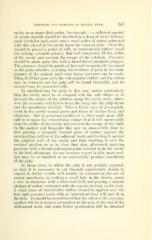Page 709 - My FlipBook
P. 709
EXPOSURE AND REMOVAL, OP DENTAL PULP. 367
cavity in an upper first molar, for example — a sufficient amount
of cocain crystals should be dissolved in a drop of water (always
made fresh for each case) and a small pellet of cotton saturated
with this placed in the cavity upon the exposed pulp. Over this
should be placed a pellet of soft, or unvulcanized rubber (used
for making vulcanite plates), that will completely fill the orifice
of the cavity and prevent the escape of the solution. Pressure
should be made upon this with a broad-faced amalgam plugger.
The pressure should be gentle at first and be gradually increased
as the pain subsides, watching for evidence of pain in the coim-
tenance of the patient, until very heavy pressure can be made.
Then, if all has gone well, the vulcanizable rubber and the cotton
may be removed and the pulp will be found insensible, and its
removal may be proceeded with.
In anesthetizing the pulp in this way, notice particularly
that the cavity must be so stopped with the soft rubber as to
prevent the escape of the solution along the cavity walls, other-
wise the pressure will fail to force the drug into the pulp tissue
and the anesthesia will fail. This is fairly easy of accomplish-
ment in the cavity named above and those of similar form and
situation. But in proximal cavities it is often much more diffi-
cult to so place the vulcanizable rubber that it will successfully
stop the orifice of the cavity and prevent the escape of the fluid.
In the molars and bicuspids this may be successfully done by
first placing a properly formed piece of rubber against the
proximating surface of the adjacent tooth and forcing it against
the gingival wall of the cavity and then doubling it over the
occlusal portion so as to close that also, afterward applying
pressure with a broad instrument point selected to fit the cavity
to the best advantage. As one becomes expert in this, most cavi-
ties may be so handled as to successfully produce anesthesia
of the pulp.
In those cases in which the pulp is not actually exposed,
so that it is necessary to cut through considerable dentin to
expose it, better results will usually be obtained in the use of
cocain anesthesia by cutting a small hole in the dentin, about
1 mm. in diameter, with a bibeveled drill, and placing a minute
pledget of cotton, saturated with the cocain solution, in this hole.
A small piece of vulcanizable rubber should be applied over the
hole and pressure made with an instrument that will just fit in
the hole. It should be remembered that the effect of the pressure
applied will be in inverse proportion to the area of the end of the
instrument used, and much better penetration will be obtained


